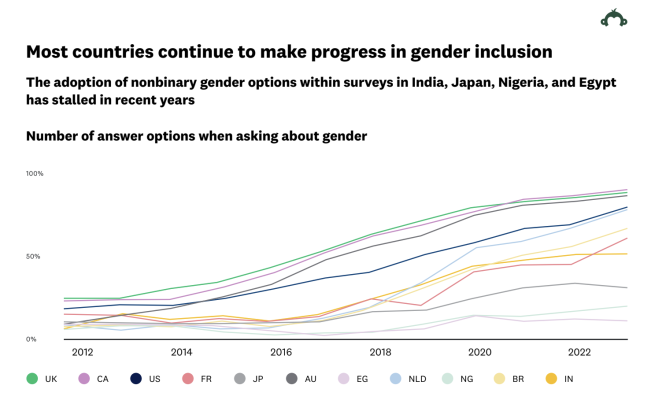Check out our 2025 State of Surveys report for the most up-to-date survey insights!
“Every question is a cry to understand the world.” Carl Sagan said it, and it’s something we’ve learned over our (almost) 25-year history. Sometimes, the questions we ask reveal as much as the answers we get back.
This is the third year for our “State of Surveys” study, where we take a deep look into the data collected on our platform. This data comes from our active users—all 17 million of them—and the 20 million questions they ask daily on SurveyMonkey.
When we started three years ago, the pandemic and the economy stood out as topics that were top of mind for our users. This year, questions about COVID were almost non-existent, while questions about AI surged—highlighting a topic that has clearly gained momentum.
Here are a couple of the most noteworthy trends and findings we discovered in our data.
AI is no longer just tech talk
Three years ago, AI developments were closed-door discussions by technology companies, covering topics like large language models, “deepfakes,” and the potential for AI-powered robots to take over jobs.
Today, the term AI has gone mainstream and wields a lot of influence. In October 2023, AI was mentioned 223 times in the earnings calls of Meta, Alphabet, and Microsoft—three companies leading the industry in AI developments. Stock market research firm WallStreetZen reported that companies that mentioned AI in their earnings calls saw an average increase in their stock price of 4.6%, compared to 2.4% for companies that didn't mention AI.
It seems that users of our platform have also been attracted to the power of using the term. AI-related wording or terms in surveys surged this year, increasing by 4x in 2023. Much of this seems to be tied to the release of OpenAI’s ChatGPT, a commercially available, open-source AI-driven chatbot that was released in September of 2022.

What are our customers asking about? Several terms stood out from the crowd, specifically the term “AI” which grew the most, increasing by nearly 10x, from 0.2% in previous years, to 1.8% in Q3 of 2023.
Terms like “artificial intelligence” and “generative AI” went from almost no mentions to around half a percent by October 2023. These more user-facing terms are on the rise compared to tech terms that were previously mentioned, like "machine learning," "deep learning," or "algorithm," which are seeing no growth.
Before we dive into this year's survey trends, here are some tips on how to include AI in your customer conversations, in your next survey, and more:
Society is becoming more gender inclusive
We’ve been watching the trend towards gender inclusivity for several years. In our 2022 study, we focused on the trend towards including three or more answer options to gender questions in surveys in the US. That number had grown significantly in 2022 compared to the previous decade, reaching 64% of surveys where a gender question was asked.
In 2023, the trend towards using 3 or more gender answer options continues to grow, and at a rapid pace around the world. In the US, almost 3 out of 4 (73%) of the surveys sent from our platform that contain a gender question include three or more answer options. Australia, the UK, and Canada register even higher rates, with over 80% of surveys with a gender question including three or more options.
And three other countries we reviewed—Brazil, the Netherlands, and France—saw double-digit growth in the number of gender answer options in surveys that included a gender question.

Gender language has also seen a shift, as the term “other” declines and the term “nonbinary” sees significant growth. In the US, 4 out of 10 surveys use the term “nonbinary” as an answer option, which is nearly triple that of “other.” And, in the UK, “prefer not to say” still tops the list but “nonbinary” has overtaken “other” as an option.
Is the shift to more inclusive gender identity a grass roots effort driven by the people creating the surveys, or a top-down decision? In September 2023, the US Census Bureau asked the Biden administration for permission to test more gender options in most comprehensive annual survey of life in the US.
So, maybe it’s a little of both—large institutions and individuals alike recognizing that collecting more accurate and specific data benefits everyone.
Looking to add gender inclusiveness to your surveys? Here are a few resources to start:
Methodology: For our 2024 study, we tracked noteworthy questions and answer options, and compared our findings to data collected during the past 11 years. We combined this data with leading-edge business intelligence practices to deliver insights into survey trends that no other feedback company can offer.
For more on our State of Surveys data for 2024, read the report.



